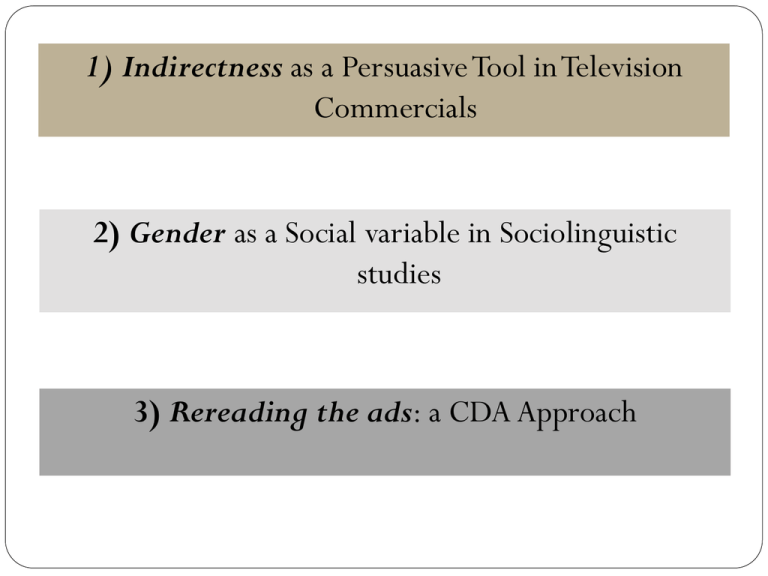Indirectness as a persuasive tool in advertising
advertisement

1) Indirectness as a Persuasive Tool in Television Commercials 2) Gender as a Social variable in Sociolinguistic studies 3) Rereading the ads: a CDA Approach Spoken Discourse It is better to define discourse ‘language in use’ than ‘language above the sentence’. ‘Language in use’: language used to do something and mean something, language produced and interpreted in a real-world context. (implicitly contrasted to the idealized, made-up example sentences ) Indirectness as a persuasive tool in advertising Advertising The term ‘advertising’ comes down to us from the Latin verb ‘advertere’ to direct one’s attention to. It is any type or form of public announcement intended to direct people’s attention to the availability, qualities, and/or cost of specific commodities or services. Advertising can be seen to fall into three main categories: 1) consumer advertising, which is directed towards the promotion of some product or service to the general public; 2) trade advertising, which is directed to dealers and professionals through appropriate trade publications and media, and 3) Public relations advertising, which is directed towards society by citizens or community groups, or by politicians, in order to promote some issues of social concern or political agenda. Persuasion It is a process of inducing a voluntary change in someone’s attitudes, beliefs or behavior through the transmission of a message(Anderson, 1978). The means for transmitting a persuasive message is language. Television, in particular, provides a well-developed example of the use of spoken language for persuasive ends. Indirectness When an interrogative structure such as can you ride a bike? ..is used with function of a question, it is described as a direct speech act. (to obtain information) When an interrogative structure such as can you pass me the salt?.. is used to make a request, it is described as an indirect speech act Forms Did you eat the pizza? Eat the pizza(please!) We ate the pizza. Interrogative Imperative Declarative Functions question Command Statement Whenever one of the structures is used to perform a function that is not corresponding to its form, the result is an indirect speech acts. Grice’s Co-operative principle There is an underlying in most conversational exchanges seems to be that the participants are cooperating with each other. Supporting this principle are four maxims, which are: The Quantity maximum: Make your contribution as is required, but not more, or less, than required. The Quality maxim: do not that which you believe to be false or for which you lack adequate evidence. The Relation Maxim: be relevant. The Manner Maxim: be clear, brief and orderly. Conventional Implicature However, we can experience conversational exchanges in which the co-operative principle may not be in operation ( that is one of the maxims is violated). An addressee will imply something that is not said relying on his background knowledge that must be shared by the conversational participants. Linguistics and the Discourse of advertising Studies of the discourse of advertising with a linguistic focus are relatively rare. Two major studies have been conducted which focus specifically on the language used in this advertising type(consumer advertising). Lakoff (1981) Lakoff noticed extensive use of novel terms on all levels of linguistic analysis ( phonological, lexical, syntactic as well as semantic novelty) . Lakoff accounts for this extensive use of linguistic novelty as follows: First, anything neologistic, draws attention to itself, thus increasing the impact of the message. (see Grice,1975). Second, neologism forces the hearer to interpret, and therefore, to participate in the discourse. • According to Lakoff, this active role played by the hearer, in turn, enhances learning and retention, and consequently persuasion. Geis(1982) He examined 800 American TV commercials Geis’s Findings: Two general approaches taken by advertisers in their language use (persuasive language). Geis’ Findings (1982) The first, the manipulative use of language which is the frequent repetition of the product name with little or no supporting argument given as to the merits of the product itself. The second, the viewer is presented with a message whose impact derives from his/her evaluation of the arguments or claim which it contains rather than the merits of the product itself. Probably the major finding of this research, however, was that advertisers favor indirect means of making claims for their products. The advertisers invite the reader to infer information through a process of conversational or conventional implicature . Geis has explained the use of conversational and conventional implicature in advertising on two grounds. First, advertisers protect themselves from prosecution for what might be indefensible claims. Second, the viewers’ cognitive defenses are much less likely to be stimulated by that which is not asserted directly. There are some other reasons e.g., ephumisim as well as avoiding the taboos. Since the claims made are implied , viewers will generally derive the intended interpretation, but with less counterargumentation. Thus, he hypothesized that this approach to making claims could actually make the message more persuasive in effect than direct claims stated explicitly. Gies discovered that the literal strength of these claims is often severely mitigated through the use of modal verbs such as can, might, may, could, and help. An Analysis of conversational commercials by Karen Hunlod Hunold believes that: Indirect utterances permit some information to be conveyed through conversational implicature and interactive frames, increasing the total information content. This means linguistic indirectness is frequently used to accomplish multiple goals. Indirect utterances is motivated by the demands of timeconstrained limitation of the tv advert. Linguistic indirectness serves more than one advertiser goal, leading to the hypothesis that indirectness is simply a verbal strategy for product presentation. It contextualizes the commercial conversation The commercial message must work on two levels: The local level, it must present an on-screen interaction with the essential structure elements of coherence, such as introduction, body, and conclusion. The fundamental level, the commercial also presents the product to the viewer, serving the communicative event between advertiser and consumer. It identifies the commercial intents. Two examples analyzed by Karen Hunlod Ad no.1 The Script A: I’v been cooking chili for 20 years. B: Well, I’ve been eating chili for 25. A: So we both know what makes Dennison’s chili great chili. It’s those firm tender beans. B: It’s that lean juicy beef. A: Larry, all you know about beef is ropin’ it. C: people can get awfully hot over chili but one thing they do agree.. A: it’s gotta be rich= B: =and thick= = like Dennison’s See how my fork stands up= B: =fork? Now, who eats chili with a fork? C: Dennson’s. So rich and thick, there’s no room for argument Conversational Commercials The commercial script have been stripped of its visual and non-verbal features. The language alone conveys enough information to 1) contextualize the commercial conversation and, 2) identify the commercial intents(recognize the product and the product attributes emphasized) in the commercial. The local level: presenting a coherent on-screen interaction Introduction, body, and conclusion Commercial Introductions The first two turns in this commercial orient the viewer to the situation, providing enough information about the speakers and the context that the viewer can follow the rest of the interaction. By using well-known expressions, the advertiser is able to tap on the wealth of the socio-cultural information brought by the viewer to the advertising context. The Script Speaker A establishes background information in his first turn. A: I’v been cooking chili for 20 years. B: Well, I’ve been eating chili for 25. A: So we both know what makes Dennison’s chili great chili. It’s those firm tender beans. B: It’s that lean juicy beef. A: Larry, all you know about beef is ropin’ it. “well” indicates that the following utterance somehow violates expectations. Speaker B appears to cut off the first speaker. The Script Introduction That the two speakers are not cooperatively constructing a single message is further revealed by “well” at the beginning of the second turn. This impression of competition orients the viewer to the interpersonal dynamics of the speakers. The Script Body The disagreement continues throughout the commercial, with each speaker offering his own opinions in opposition to those of his conversational partner, it is no accident that through this disagreement, the product is presented to viewers. Commercial Conclusions Commercial conclusions also organize the onscreen event. Like any other type of closing, these conclusions wind up the present activity. This occurs simultaneously on both the onscreen level and on the fundamental level between the advertiser and the viewer. The Script Conclusion We find a strong closing strategy exhibited in the script. The two speakers competed for the floor throughout the commercials, indicated by the production of similarly constructed but lexically different claims. In the closing turns, they resolve the competition over the product (and move it to a different field). Breaking the pattern is a way of indicating that the episode is complete. C: people can get awfully hot over chili but one thing they do agree.. A: it’s gotta be rich= B: =and thick= = like Dennison’s See how my fork stands up= B: =fork? Now, who eats chili with a fork? C: Dennson’s. So rich and thick, there’s no room for argument. a voiceover closes the commercial, reinforcing the competition of the episode. The local level One can see that each utterance contributes to the organization of the onscreen activity, how it informs and orients the viewer not so much about the product as on-going activity. The fundamental level: Communication between advertiser and viewer How utterances serve the advertiser The Fundamental Level Three distinct functions which utterances can serve for the advertiser: 1) They can present the product, 2)They can contextualize the product, the product use, or product users; 3) they can support the product presentation (Hunold, 1987a). 1) Presenting the product In the Script , quite a few utterances clearly present the product. The Script Speaker A product Presentation A: I’v been cooking chili for 20 years. B: Well, I’ve been eating chili for 25. A: So we both know what makes Dennison’s chili great chili. It’s those firm tender beans. B: It’s that lean juicy beef. A: Larry, all you know about beef is ropin’ it. Speaker B Product Presentation C: people can get awfully hot over chili but one thing they do agree.. A: it’s gotta be rich= B: =and thick= = like Dennison’s See how my fork stands up= B: =fork? Now, who eats chili with a fork? C: Dennson’s. So rich and thick, there’s no room for argument. the two speakers jointly present the product in their utterance The contextualization of the product They also contextualize product use, demonstrating either situations in which product use is appropriate or indicating what kind of people use the product. The script employs contextualizers which convey such information. The ad indicates that people who use the product are sociable, active, and so on. It indicates that the speakers are in competition, that they are rivals, with the implication that the heartiness of the speakers is mirrored in the product. These impressions are connotations directly conveyed by the linguistic structure of the conversationally situated used in the commercial. Supportive utterances Supportive utterances contribute to the advertiser’s purpose by inviting product presentation. In the script , the voiceover says, “ but on one thing they do agree.” this utterance invites the speaker to present the product, as indeed is done. Each utterance also contributes to the essential communication between advertiser and viewer. C: people can get awfully hot over chili but one thing they do agree.. A: it’s gotta be rich= B: =and thick= = like Dennison’s See how my fork stands up= B: =fork? Now, who eats chili with a fork? C: Dennson’s. So rich and thick, there’s no room for argument. the two speakers jointly present the product in their utterance Organizing product presentation: Direct &Indirect Messages We will focus on the verbal strategies for organizing product presentation. Of course , commercials exhibit a great variety in the ways they present products. Directness in commercials We might come to the conclusion that the only direct utterances on the fundamental level, the advertiser-consumer interaction, is of the form “BUY THIS PRODUCT.” This fundamental directness must be contrasted with the many linguistically direct utterances which occur on the local level. For example: “ Tab has only one calorie” “Palmolive’s great;” “ I love Soup-for-One;” “Dove is ¼ cleaning cream.” They are direct on the local level, but are indirect on the fundamental level because it tells you WHY you should buy the product rather than simply to BUY the product. So, the linguistic directness of the local onscreen utterance must be distinguished from directness on the fundamental level. A whole range of relationships exists between directness on the two different levels. Indirectness Advertising is under conflicting pressures: long on information, short on time. One way to resolve these pressures is to accomplish multiple goals with single utterances, thus killing two birds with one stone. Indirect utterances can accomplish this. For example, “hard to believe that’s one calorie” indirectly conveys subjective information about taste. directly conveys factual information about calorie content Indirectness resolves the competing demands of informing the viewer and motivating the viewer to buy by allowing a single utterance to perform both jobs. Another example of indirectness is in the slogan: “oh Fab, we’re glad there’s full strength fabric softener in you.” indirectly conveys subjective information: something to be glad for. directly conveys factual information about fabric softer The following exchange offers a classic example of indirectness: A: “Why did you buy those laxative pills instead of Feen-a-mint?” B: “ I didn’t know Feen-a-mint ever made a pill.” The first turn indirectly conveys the existence of Feen-a-mint pills. The response indirectly conveys the impression that, had this been known, It would have been the laxative pill of choice. While conveying these impressions, the utterances contextualize the interaction. Indirectness offers advertisers a linguistic strategy for making product claims serve more than one purpose at once. Some claims that could be made directly are made indirectly in order to convey some other message at the same time. For example, the indirect message “hard to believe that’s one calorie” accomplishes two goals instead of the single goal of informing, had the caloric content of the soft drink been directly conveyed. Final Comment A problem from the advertiser’s point of view with indirectness is that the addressee might miss some point, either deliberately or accidently. This potential problem can create particular concern in advertising, when success entails the consumers’ getting of point. However, indirect utterances do more than merely convey facts. They actively contextualize the utterance, thereby providing information of a different but less important sort. They contribute crucially to persuasion and consumer attitudes toward the product. In other words, indirectness in commercials is simply advertisers doing with commercial language what people in natural settings do with natural language: when there is a need to accomplish several goals at once, indirectness is used. Indirectness is cultural specific





